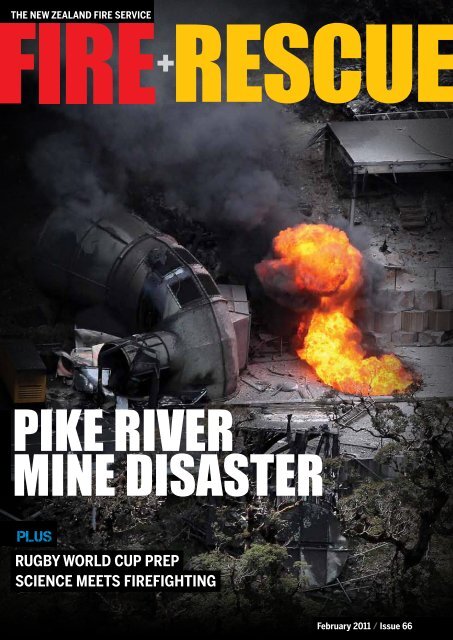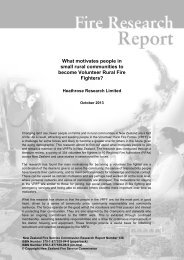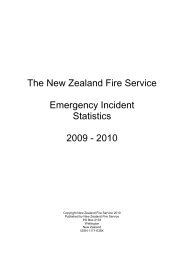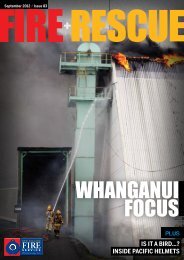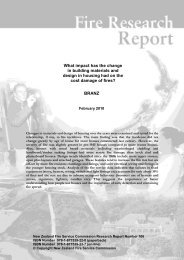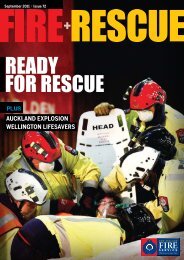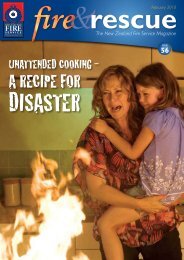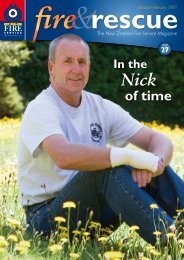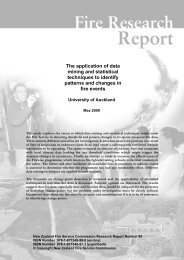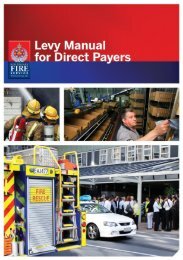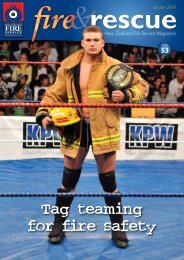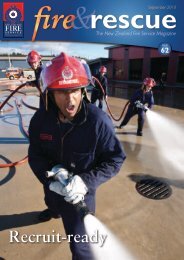Download PDF: Fire+Rescue - Issue 66 - New Zealand Fire Service
Download PDF: Fire+Rescue - Issue 66 - New Zealand Fire Service
Download PDF: Fire+Rescue - Issue 66 - New Zealand Fire Service
You also want an ePaper? Increase the reach of your titles
YUMPU automatically turns print PDFs into web optimized ePapers that Google loves.
the new <strong>Zealand</strong> fire service<br />
pike river<br />
mine disaster<br />
Plus<br />
rugby world cup prep<br />
science meets firefighting<br />
february 2011 / issue <strong>66</strong>
the new <strong>Zealand</strong> fire service<br />
<strong><strong>Fire</strong>+Rescue</strong> is the flagship<br />
publication of the <strong>New</strong> <strong>Zealand</strong><br />
<strong>Fire</strong> <strong>Service</strong>.<br />
It is produced by Media,<br />
Promotions and Communications,<br />
National Headquarters,<br />
Level 9, 80 The Terrace, Wellington.<br />
contributions to fire+rescue<br />
We welcome ideas for articles, news<br />
and events that would be of interest to<br />
other <strong>Fire</strong> <strong>Service</strong> staff and volunteers.<br />
Draft articles and photos (pictures<br />
need to be at least 1MB) can be<br />
emailed to fire.rescue@fire.org.nz or<br />
contact the editor Karlum Lattimore<br />
on 04 496 3702.<br />
Post written material and photos,<br />
or photo CDs to:<br />
<strong><strong>Fire</strong>+Rescue</strong> magazine,<br />
PO Box 2133, Wellington.<br />
(These will be returned on request.)<br />
www.fire.org.nZ<br />
All material in <strong><strong>Fire</strong>+Rescue</strong> magazine<br />
is copyrighted and may not be<br />
reproduced without the permission<br />
of the editor.<br />
ISSN: 1176-<strong>66</strong>70<br />
front cover<br />
Gases burn at the Pike River mine<br />
shaft. Photo: NZPA<br />
2 / <strong><strong>Fire</strong>+Rescue</strong> / February 2011<br />
new look fire+rescue<br />
Yes there is something different about <strong><strong>Fire</strong>+Rescue</strong>. We’ve given it a make-over<br />
to freshen its look and provide more variety in the design. You might notice that<br />
it now looks a bit like the NZ Rugby and Fishing magazines – we shamelessly stole some<br />
of their design features and hope you like the result.<br />
We still rely heavily on <strong>Fire</strong> <strong>Service</strong> personnel from around the country to alert us to the<br />
news and interesting initiatives underway in their neck of the woods, so please contact<br />
us at fire.rescue@fire.org.nz if you have a story to tell, or if you want to provide some<br />
feedback on the new look. You can also call the editor Karlum Lattimore on 04 496 3702.<br />
it’s not just an urban myth<br />
<strong>Fire</strong>fighters do rescue cats<br />
from trees.<br />
Sockburn Senior <strong>Fire</strong>fighter Garry Dillard<br />
is clearly a sucker for a sob story.<br />
When three young women told the<br />
tale of how their cat had been stuck<br />
20 metres up a tree for 15 hours he<br />
came to the rescue.<br />
social chit chat<br />
Facebook is an informal, real-time,<br />
social phenomenon that the <strong>Fire</strong><br />
<strong>Service</strong> is using to become more personally<br />
involved in discussions around fire safety<br />
and our emergency response.<br />
So far we have over 6,200 members,<br />
including 1,400 from other countries.<br />
So, when large incidents, such as the<br />
Pike River Coal Mine disaster happen,<br />
we are able to share in the discussion and<br />
make a few comments about our response.<br />
The Facebook community wants to see<br />
what we are saying. In the days after the<br />
explosion in the mine, the number of<br />
Garry and his crew tried squirting water<br />
from a hose reel up on to the cat but<br />
that only encouraged it to climb higher.<br />
So Garry kicked off his boots and<br />
according to eyewitnesses ‘scaled the<br />
tree like a monkey boy’ to grab the cat.<br />
As you can see, his action was much<br />
appreciated by the women.<br />
people clicking through each week to<br />
our page or reading the comments rose<br />
dramatically – up from 135 to 2,749.<br />
There were similar large increases in<br />
interest after the Canterbury earthquake.<br />
We also provide links from our Facebook<br />
page to our new YouTube channel where<br />
we’ve posted informative clips from K99<br />
and some of our television advertisements.<br />
So tell your Facebook friends about our<br />
page – we plan to keep up the interaction<br />
and build on the possibilities for discussion<br />
that it offers.
Consulting the crystal ball<br />
As I approach the end of my time with our <strong>Service</strong>, I’ve taken the opportunity to<br />
discuss with the Commission, the Minister and others, the changes, challenges<br />
and opportunities our <strong>Fire</strong> <strong>Service</strong> might explore over the next few years.<br />
Ithink we are all well aware that<br />
firefighting has become just one part<br />
of what we do. Medical calls, road<br />
crashes and civil defence emergencies<br />
form a significant part of our workload.<br />
We are also a national resource for major<br />
incidents. Just look back at the last few<br />
months of 2010 when we deployed people<br />
and equipment from around the country<br />
first for the Canterbury earthquake and<br />
then the Pike River mine disaster.<br />
This year, one of the larger demands on<br />
us will come from the Rugby World Cup –<br />
providing fire risk management advice,<br />
response preparation and incident<br />
command facilities.<br />
Change is needed<br />
We will continue to have a strong focus<br />
on preventing fires by providing fire<br />
safety advice and public education<br />
through a wide variety of initiatives<br />
within our communities.<br />
But what we do today is a long way from<br />
what we did when the <strong>New</strong> <strong>Zealand</strong> <strong>Fire</strong><br />
<strong>Service</strong> was set up over 35 years ago.<br />
The <strong>Fire</strong> <strong>Service</strong> Act of 1975 and its<br />
regulations haven’t fundamentally<br />
changed since then and neither has the<br />
way we are funded. We continue to work<br />
with government to refine our funding<br />
mechanisms to ensure that those who<br />
legally (and morally) need to contribute<br />
to our <strong>Service</strong> are made to do so. We will<br />
also continue our discussions about the<br />
potential to change our Act to give a clear<br />
mandate for what we already do, and the<br />
appropriate legal support to do so.<br />
going green<br />
The world is also going ‘green’. There is<br />
an increasing demand for organisations<br />
to find ways to minimise their impact on<br />
the environment and the <strong>Fire</strong> <strong>Service</strong> is<br />
no exception.<br />
As I gaze into my crystal ball, I see many<br />
changes ahead for this organisation.<br />
We will need to reflect the concern for<br />
the environment, by using smaller, lighter,<br />
possibly hybrid fuel or electric appliances<br />
and increasingly using compressed air<br />
foam (CAF) to both suppress the products<br />
of combustion and reduce the use of<br />
water and run-off pollution.<br />
We will also need to start thinking about<br />
how to better respond to the needs of<br />
our local communities by taking a more<br />
risk-based focus via application of our<br />
National Resource Allocation Model<br />
(NRAM) and make sure brigades are<br />
primarily resourced to reflect the actual<br />
risk they cover, both in their equipment<br />
and their training.<br />
new ways of responding<br />
There are lots of things we do well, but<br />
there are others we no longer need to do<br />
in the same old way. For instance, alarm<br />
systems in new buildings are becoming<br />
increasingly sophisticated and include<br />
video and data recordings that can be sent<br />
to emergency services. This will shape the<br />
way we respond to automatic alarms.<br />
We already know that almost all PFAs<br />
(Private <strong>Fire</strong> Alarms) are false alarms.<br />
Future PFA thinking will inevitably move<br />
us to a position of ‘it’s a false alarm until<br />
proven otherwise’ rather than our current<br />
response. Whilst I don’t personally agree<br />
with the nil response to PFAs approach<br />
taken by some English brigades, moving<br />
to a smaller investigative response to<br />
most PFAs is certainly on the cards. I can’t<br />
see us responding with motor cycles in<br />
the near future as we don’t have the traffic<br />
issues they have in other parts of the<br />
world, but there are any number of small<br />
fire and investigation response options<br />
emerging. Not all calls need a full crew or<br />
are response-time critical, nor do we need<br />
unnecessarily large trucks to do the job.<br />
Lead the Change<br />
The smart organisation recognises<br />
the challenges ahead, and seizes<br />
the initiative and makes the decisive,<br />
informed, changes necessary to meet<br />
those challenges.<br />
The question facing us is do we have<br />
the vision and strength to recognise,<br />
and turn to our advantage, the challenges<br />
and opportunities of the next few years.<br />
It’s your future.<br />
Mike Hall<br />
CE/National Commander<br />
A possibility for <strong>New</strong> <strong>Zealand</strong>?<br />
editorial<br />
<strong><strong>Fire</strong>+Rescue</strong> /February 2011 / 3
inside the fire<br />
Pike<br />
our<br />
River Coal Mine<br />
role<br />
disaster<br />
4 / <strong><strong>Fire</strong>+Rescue</strong> / February 2011
Christchurch SSO Mike Bowden arrived for work at 5.15pm on Friday 19 November<br />
and within an hour was on his way to the Pike River Coal Mine near Greymouth,<br />
where a massive explosion had taken place while 29 men were underground.<br />
Over the next three weeks more<br />
than 50 <strong>Fire</strong> <strong>Service</strong> personnel and<br />
Rural <strong>Fire</strong> officials rotated in and<br />
out of the West Coast to provide support<br />
to the Police-led operation.<br />
Most came from Canterbury and<br />
were based at the mine along with the<br />
Christchurch hazmat/command unit which<br />
was used largely as a communications<br />
base and handling air operations. The first<br />
crew sent over with the hazmat/command<br />
unit included Senior <strong>Fire</strong>fighter Wayne<br />
Hamilton, who is also an air operations<br />
supervisor with the Canterbury Rural <strong>Fire</strong><br />
Authority, and Station Officer Shane Cole.<br />
It was handy that just a month earlier some<br />
of the Christchurch <strong>Fire</strong> <strong>Service</strong> personnel,<br />
including Mike, Wayne and Area Manager<br />
Dan Coward, had done night-time air<br />
operations training with the helicopter<br />
company contracted to do the night flying<br />
ops for the Pike River emergency.<br />
“The crews on the command unit all took<br />
their turn at managing the air operations,”<br />
said Mike. “There’s not too much difference<br />
in talking to a pilot or a pump operator.<br />
It’s all about keeping a handle on what’s<br />
needed, what’s going on and logging<br />
what’s happened.”<br />
To support the initial Police response the<br />
command unit also prepared an Incident<br />
Action Plan for the first days of operation<br />
at the mine using a modified template<br />
that had been developed during the<br />
response to the Canterbury earthquake.<br />
Over the coming days two crews of four<br />
rotated in for four-day stretches, working<br />
12-hour shifts. Once the GAG (Gorniczy<br />
Agregat Gasniczy) machine was operating<br />
to stabilise the mine environment, two<br />
personnel from the Christchurch support<br />
pump crew provided the spray needed<br />
to keep it cool. They also provided<br />
protection during the transfer of avgas<br />
while it was refuelled. Two fires were dealt<br />
with by the teams at or near the GAG,<br />
which generated some action, said Mike.<br />
<strong>Fire</strong><br />
Christchurch City SSO Dave Stackhouse<br />
was on hand for the fire at the portal<br />
caused by spontaneous combustion of<br />
the foam used to seal the mine entrance<br />
before installing the GAG.<br />
It was about 6.30am and Dave and SFD<br />
Dave Riddell were the only NZFS staff<br />
on duty. “We were slightly stretched to<br />
say the least but got it out with the help<br />
of a couple of Queensland mines rescue<br />
chappies and great firefighting initiatives<br />
from Dave Riddell,” he said.<br />
LocaL knowLedge<br />
West Coast Area Manager Mark Boere<br />
says the Ikamatua, Reefton and<br />
Greymouth brigades responded to<br />
the first explosion. Transalpine Region<br />
Commander Rob Saunders led the initial<br />
<strong>Fire</strong> <strong>Service</strong> response with Mark taking<br />
over the following day as executive<br />
officer on-site and liaison as demands<br />
for resources grew.<br />
“Once the response structure was in<br />
place, with executive officers coming<br />
in from outside the region to provide<br />
assistance, I turned my focus to overall<br />
area activities and supporting the local<br />
brigades, many of whom had personal<br />
links with those at the mine.”<br />
Mark is also the local Principal Rural <strong>Fire</strong><br />
Officer and was an important link in the<br />
planning for the response to fire.<br />
importance oF agency<br />
reLationships<br />
“Between the earthquake in September,<br />
the air disaster at Fox Glacier and the<br />
mine emergency it was a horrendous few<br />
months for emergency services. However,<br />
all these events have shown the value<br />
of the CIMS (Coordinated Incident<br />
Management System) structure for us<br />
and for the different agencies involved.<br />
It’s also shown how much we all rely on<br />
the relationships between agencies at<br />
a local level. Everyone draws on these<br />
relationships when there is a national<br />
effort underway.”<br />
Mark has also seen the results of the<br />
strong feeling of fraternity between<br />
<strong>Fire</strong> <strong>Service</strong> personnel.<br />
“When these big things happen the<br />
support from the <strong>Fire</strong> <strong>Service</strong> community<br />
is amazing, both operationally and in<br />
terms of welfare. There is also genuine<br />
concern shown by fellow firefighters from<br />
around the country. We saw this happen<br />
in Canterbury after the earthquake and<br />
again here at Pike River,” he said.<br />
“The value of the new hazmat/command<br />
unit cannot be overstated,” he said.<br />
“Its worth has been commented on by<br />
everyone from local police through to<br />
the Minister,” said Mark.<br />
Listening in vain<br />
Three days after the first explosion<br />
two Christchurch USAR (Urban Search<br />
and Rescue) technicians, SFF Garry Dillard<br />
and SFF Tony West, were sent in with<br />
listening devices to help find any indication<br />
that some of the men may still be alive<br />
below ground.<br />
<strong><strong>Fire</strong>+Rescue</strong> /February 2011 / 5
Left top: QFF Josh Kumberoff and SFD Tom Pierce at the GAG. Left bottom: AAM Steven Greenyer (Timaru), AAM Tim Bennion (Nelson) and SFD Chris Freeman<br />
(Christchurch) in the hazmat/command unit. Middle: Vent shaft is capped. Right: The fire-blackened mine portal.<br />
To test whether the equipment could pick<br />
up sounds from the far end of the two<br />
kilometre shaft leading into the mine,<br />
the pair first connected the equipment<br />
to pipes near the hazmat/command unit<br />
which was about a kilometre from the<br />
mine entrance. Taskforce Two leader<br />
Paul Burns said “The equipment worked<br />
perfectly. They could even hear water<br />
droplets.” The listening device was then<br />
attached to the compressed air pipes<br />
that led into the mine and monitoring was<br />
done from a safe point to one side of the<br />
portal. The device was also later attached<br />
to the bore that was driven into the mine<br />
to test the atmosphere.<br />
ruraL <strong>Fire</strong>Fighting<br />
At the beginning of the second week<br />
of the operation, a National Incident<br />
Management Team from rural fire<br />
authorities was called in to complete<br />
a risk assessment and plan for any<br />
vegetation fire that might take hold at<br />
the ventilation shaft or the mine portal.<br />
Team Leader Bryan Cartelle said “We were<br />
very focused on how we could assist and<br />
contribute to the bigger operation – that’s<br />
what emergency management is all about.<br />
As Team Leader I was at the family<br />
meetings and it was good to be able to<br />
talk to people and answer their questions<br />
about our work. Understandably there<br />
6 / <strong><strong>Fire</strong>+Rescue</strong> / February 2011<br />
Understandably there<br />
was a lot of sadness but<br />
it was important to be<br />
there for those people.<br />
was a lot of sadness but it was important<br />
to be there for those people.”<br />
Once the risk assessment was completed<br />
the tasking was handed over to the West<br />
Coast Rural <strong>Fire</strong> District with the Grey<br />
District Council as zone controller. A rural<br />
air operations manager took on overall<br />
responsibility for any fire response and for<br />
the air operation to put the lid on the vent.<br />
capping the vent<br />
As concern grew over the fire coming<br />
from the vent, a request was made by<br />
the operations centre at Pike River to see<br />
if there was a way to put it out or minimise<br />
it. It appeared the gasses were catching<br />
fire when they combined with oxygen in<br />
the air near the mouth of the vent. It was<br />
thought that cooling the area around the<br />
vent would make it safer to cap and,<br />
combined with using the GAG machine,<br />
this could help slow and eventually<br />
stop the ignition.<br />
Bryan Cartelle said the first step was to<br />
determine how practical it would be to<br />
install a pumping operation which would<br />
include bringing in pumps, a portable dam<br />
and other equipment by helicopter and<br />
gaining foot access to the ventilation shaft<br />
and a stream. “Once we determined it was<br />
possible, we had a crew cut a safe access<br />
path from the helipad and the vent shaft<br />
down to the stream a steep 35 minutes’<br />
walk below. <strong>Fire</strong> <strong>Service</strong> and Department<br />
of Conservation crews then set up pumps<br />
to bring the water up to a portable dam<br />
allowing a fine mist to be sprayed onto<br />
the concrete pad at the vent.<br />
<strong>Fire</strong> <strong>Service</strong> personnel stripped the new<br />
prototype water tanker that had just been<br />
delivered to Christchurch and flew its<br />
portable pumps and dam in for the job.<br />
Christchurch staff also went out on<br />
helicopter sweeps across the area to<br />
monitor the heat from the vent shaft<br />
and at the platform, using thermal<br />
imaging equipment.<br />
setting up structures<br />
South Canterbury Area Manager<br />
Paul Henderson was one of the first<br />
<strong>Fire</strong> <strong>Service</strong> personnel to arrive. He set<br />
up the structure for the <strong>Fire</strong> <strong>Service</strong> daily<br />
operation. An Assistant Area Manager<br />
was placed at the mine to attend all major
meetings, plan and oversee the role of the<br />
command unit in carrying out what was<br />
needed. An Area Manager was based in<br />
Greymouth to attend and provide input<br />
to the inter-agency meeting held each<br />
morning. The Area Manager also attended<br />
the afternoon planning meetings at the<br />
mine. Senior station officers were involved<br />
in risk management planning and logistics.<br />
“Our role was to ensure that we worked<br />
in collaboration with other agencies to fulfil<br />
whatever was required of us as quickly and<br />
effectively as possible,” said Paul.<br />
As with the response to the Canterbury<br />
earthquake, Paul said the new hazmat/<br />
command unit, proved to be a vital tool in<br />
a major emergency. “It was worth its weight<br />
in gold and its crew were outstanding.<br />
They handled the air operations of a lot<br />
of helicopters while I was there that first<br />
weekend. As a pilot, I was impressed with<br />
their proficiency.”<br />
nhQ roLe<br />
Back in Wellington, National Manager<br />
Special Operations Jim Stuart-Black<br />
and National Director of <strong>Fire</strong> Risk<br />
Management Paula Beever were part<br />
of the panel of experts drawn on by the<br />
Pike River mine operation team at Police<br />
Headquarters. They provided input to<br />
critical decisions being made based on<br />
the data about the gases and other<br />
conditions in the mine.<br />
“They also wanted us to help them<br />
understand some of the technical<br />
terminology and data that were being<br />
used,” said Paula who made two trips<br />
to Greymouth with officials as the<br />
operation progressed.<br />
NHQ staff also helped with the logistics<br />
of rotating <strong>Fire</strong> <strong>Service</strong> personnel in and<br />
out of the region during the response.<br />
<strong>Fire</strong> service community<br />
mourns Loss<br />
Milton Osborne, miner and Deputy Chief<br />
<strong>Fire</strong> Officer of the Ngahere Brigade, was<br />
one of the 29 men killed in the mine<br />
explosion. He was a highly valued member<br />
of the Ngahere Volunteer <strong>Fire</strong> Brigade for<br />
17 years and his contribution and energy<br />
will be sorely missed.<br />
Two other men who died, Kane Nepier<br />
and David Hoggart, were the sons of<br />
volunteer firefighters. The <strong>Fire</strong> <strong>Service</strong><br />
extends its condolences to their families<br />
and brigades.<br />
Below: The GAG machine in operation.<br />
Right: Milton Osborne and his wife Anna.<br />
Extract from Ngahere Chief<br />
<strong>Fire</strong> Officer Tom Daly’s<br />
words in remembrance<br />
of Milton Osborne.<br />
“Milt was a man who served<br />
his community impeccably<br />
but didn’t seek out any<br />
praise or special mention.<br />
When the previous CFO,<br />
Gary Donaldson, retired,<br />
we all wanted Milt to<br />
step up and take the job.<br />
But that wasn’t Milton.<br />
He was happy being out<br />
of the limelight just doing<br />
whatever he could to help<br />
the brigade and the people<br />
of Ngahere. Nothing was<br />
ever a problem to him but<br />
when the going got tough<br />
he was the firefighter all the<br />
members wanted watching<br />
our backs.<br />
Once met never forgotten.<br />
Rest in peace mate.”<br />
<strong><strong>Fire</strong>+Rescue</strong> /February 2011 / 7
feature<br />
Preparing for<br />
kick off<br />
The Rugby World Cup is the largest sporting event <strong>New</strong> <strong>Zealand</strong> has hosted.<br />
It will also be one of the most operationally demanding events the <strong>Fire</strong> <strong>Service</strong><br />
has ever supported.<br />
Already the government has made it<br />
clear that it expects all agencies and<br />
organisations to work collaboratively<br />
and effectively to make the event a success.<br />
As National Commander/Chief Executive<br />
Mike Hall said at the recent <strong>Fire</strong> Risk<br />
Management Conference, this doesn’t<br />
mean that public safety is compromised.<br />
“What it does mean is that we will be<br />
flexible. We will pull out all the stops to<br />
make sure we do everything we can to<br />
facilitate the various demands that will be<br />
made on us – whether that is processing<br />
evacuation schemes, providing a presence<br />
at rugby grounds or providing fire risk<br />
management advice to venues, liquor<br />
licensing authorities, pyrotechnic<br />
specialists, local authorities and other<br />
agencies. But none of this work will be<br />
done at the expense of public safety.”<br />
8 / <strong><strong>Fire</strong>+Rescue</strong> / February 2011<br />
high-LeveL invoLvement<br />
The <strong>Fire</strong> <strong>Service</strong> is working with other<br />
agencies at a national level to help<br />
coordinate and plan for the event.<br />
This includes the work being done to<br />
maintain security at the venues and hotels.<br />
National Manager Special Operations<br />
Jim Stuart-Black is leading the <strong>Fire</strong> <strong>Service</strong><br />
commitment.<br />
“It’s going to be a busy and exciting time for<br />
the organisation. For several months now<br />
we’ve been taking part in a series of external<br />
meetings and exercises to plan for a variety<br />
of situations involving transportation or civil<br />
defence emergencies through to power<br />
failures and criminal activity. We’re also<br />
planning for the risks, including fire, posed<br />
The 2008 All Blacks helped launch Tourism <strong>New</strong> <strong>Zealand</strong>’s United Kingdom promotion of the Rugby World Cup.<br />
by floating hotels, large numbers of<br />
camper vans on the move and temporary<br />
accommodation that will be used by<br />
visitors during the event,” he said.<br />
The <strong>Fire</strong> <strong>Service</strong>’s own planning takes<br />
in three main areas; ICT (information and<br />
communications technology) support,<br />
operations and fire risk management.<br />
“We will need to be able to link in to the ICT<br />
infrastructure being put in place at venues<br />
as well as leverage off the new fleet of<br />
hazmat/command units around the<br />
country that will be used as part of our<br />
support to the Police operation,” he said.<br />
“Operationally, much of our work will involve<br />
the usual planning of responses for road<br />
closures, temporary dwellings and providing<br />
a stand-by presence for VIP hotels, training<br />
Photo: NZPA/Tim Hales<br />
Steve Turek<br />
Rugby World Cup Chief Executive<br />
Martin Sneddon meets with Alan<br />
Merry to talk about the coming event<br />
and what it will mean to <strong>New</strong> <strong>Zealand</strong>.<br />
See K99 for the full interview.
fACt<br />
grounds and match venues. All regions will<br />
be part of local coordination centres to help<br />
with this response,” said Jim.<br />
deaLing to <strong>Fire</strong> saFety<br />
Principal Advisor <strong>Fire</strong> Risk Management<br />
Alan Merry said he expects there will be<br />
a lot of last minute requests relating to<br />
temporary party venues, game grounds<br />
and street closures.<br />
“Most of the work will be handled at<br />
a regional level but we have set up a<br />
structure so that there is a nationally<br />
consistent and coordinated approach<br />
to the advice we give,” he said.<br />
This will include advice on applications<br />
for pyrotechnic displays, advice to building<br />
owners and local authorities, evacuation<br />
scheme advice, liquor licensing issues,<br />
proactive management of alarm systems<br />
in hotels where VIPs are staying and other<br />
general built environment queries.<br />
“Each region has a representative on<br />
the national group who has helped form the<br />
national guidelines. These regional reps are<br />
the first point of contact for issues that have<br />
arisen at a local level. They will also take<br />
matters that need wider consideration to<br />
the national group for discussion,” said Alan.<br />
on the board<br />
85,000 overseas visitors expected<br />
2,500 media expected<br />
2,000 VIPs expected<br />
The <strong>Fire</strong> <strong>Service</strong> National Director of<br />
<strong>Fire</strong> Risk Management, Paula Beever,<br />
has been appointed to the Rugby World<br />
Cup Authority (RWC Authority). Of the 20<br />
members of the Authority, she is just one<br />
of three who is not a lawyer. The Authority<br />
is a temporary body able to fast track<br />
applications for activities or liquor<br />
licences linked to the Rugby World Cup.<br />
“It’s early days so we are all still getting<br />
a feel for what we will be doing,” she said.<br />
The Authority will work in panels of three,<br />
who will assess applications for activities<br />
and may hold hearings to listen to the views<br />
of interest groups raising concerns about<br />
specific applications.<br />
Most applications are likely to be dealt with<br />
using normal consent processes at a local<br />
level by councils and other agencies;<br />
however, the Authority will deal with those<br />
that are urgent for one reason or another.<br />
Paula says she isn’t on the Authority<br />
to represent the <strong>Fire</strong> <strong>Service</strong>, but will<br />
be a source of expert advice on fire risk<br />
management matters.<br />
the british experience<br />
Some of the issues facing <strong>New</strong> <strong>Zealand</strong><br />
in preparing for the Rugby World Cup are<br />
similar to those that Britain is experiencing<br />
as it gears up for the 2012 Olympics.<br />
Former Auckland Region Commander and<br />
now Assistant Commissioner <strong>Fire</strong> Safety<br />
Regulation with the London <strong>Fire</strong> Brigade,<br />
Steve Turek, is closely involved with the<br />
British preparations.<br />
He spoke about this, and some of the other<br />
issues that English brigades are facing,<br />
at the <strong>Fire</strong> Risk Management Conference<br />
in Rotorua in November.<br />
With a mix of new and temporary facilities,<br />
some of the fire risk management issues<br />
are quite complex both during construction<br />
Paula Beever<br />
and once they’re in use. Added to the mix<br />
is all the audio-visual, computer-related<br />
and other technical equipment, cabling<br />
and wiring that will be put in place at the<br />
various media centres. And then there<br />
are all the security requirements.<br />
“We have had two fire engineers embedded<br />
in the planning for the past two years and<br />
we have a Central <strong>Fire</strong> Engineering Support<br />
Group involved in all planning applications.<br />
They also have oversight of the fire safety<br />
issues involved with many of the major<br />
projects. There are also fire safety support<br />
teams in associated boroughs that provide<br />
liaison, advice and guidance on everyday<br />
fire safety and protection issues,”<br />
explained Steve.<br />
Some of the issues being faced relate<br />
to construction – with over 10,000 people<br />
spread across the venues and other<br />
worksites. “Many don’t speak good English,<br />
they have different cultural attitudes toward<br />
fire safety and some of the accommodation<br />
they are in is unsuitable,” said Steve.<br />
Like the <strong>Fire</strong> <strong>Service</strong> Rugby World Cup<br />
planners, the London <strong>Fire</strong> Brigade is also<br />
examining issues relating to the influx of<br />
visitors. There are fire safety issues to be<br />
considered for their accommodation,<br />
entertainment, venues and transport.<br />
“One of our basic issues is just how<br />
to promote the UK emergency number,<br />
which is 112 and quite different from<br />
the emergency number in many other<br />
countries,” he said.<br />
These are all matters that <strong>New</strong> <strong>Zealand</strong><br />
will be looking at as well, said Steve.<br />
<strong><strong>Fire</strong>+Rescue</strong> /February 2011 / 9
fACt<br />
feature<br />
Participating countries playing to qualify<br />
1987 16 1991 31 1995 52 1999 69 2003 82 2007 94<br />
Total cumulative average television audience (million)<br />
1987 230 1991 1,400 1995 2,380 1999 3,100<br />
2003 3,441 2007 4,200<br />
the nZfs rwc planning<br />
representatives<br />
National – Jim Stuart-Black<br />
Northland – Graham Dakin<br />
Auckland – Richard Twomey<br />
Bay Waikato – Brent Mortensen<br />
Eastern – Ken Cooper<br />
Western – Kerry Stewart<br />
Arapawa – Des Irving<br />
Transalpine – Dan Coward<br />
Southern – Roger Smith<br />
<strong>Fire</strong> Risk Mgt – Alan Merry<br />
ICT – Alma Hong<br />
The national guidelines for advice<br />
will be released shortly – look out<br />
for the operational instructions<br />
on <strong>Fire</strong>net.<br />
Jim Stuart-Black<br />
10 / <strong><strong>Fire</strong>+Rescue</strong> / February 2011
measuring the effort –<br />
firefighting meets technology<br />
fACt<br />
If you want to know just how physically demanding it is to be a rural firefighter,<br />
Dr Richard Parker can tell you.<br />
the Rotorua-based Scion researcher<br />
used a mix of recording equipment<br />
to measure the stress and fatigue<br />
on rural firefighters at a fire. A special belt<br />
measured their heart rate while a camera<br />
mounted in the helmet recorded what<br />
they saw and heard. Another monitor<br />
strapped to the helmet measured their<br />
carbon monoxide exposure while a GPS<br />
unit tracked their progress on the ground.<br />
All the recordings were taken while the<br />
firefighters clambered up hillsides,<br />
dragged hoses, set up dams and<br />
scraped out fire breaks.<br />
Richard’s ground-breaking research was<br />
funded by the <strong>Fire</strong> <strong>Service</strong> Commission<br />
Contestable Research Fund and will be<br />
used to help refine the guidelines relating<br />
to shift length and fatigue.<br />
It’s the first time these types of stress<br />
measurements have been taken in a reallife<br />
situation.<br />
technoLogy revoLution<br />
“We started doing this sort of research<br />
four years ago but the camera and<br />
monitors were quite bulky and took too<br />
long to put on and when they were<br />
attached to the firefighter, the equipment<br />
got in the way of the firefighting. So it<br />
wasn’t very practical. But now, technology<br />
has moved on and everything is small<br />
enough to be easily fitted onto the<br />
helmet,” he said.<br />
Once the fire was out and the firefighters<br />
were back home, they sent data back<br />
to Richard who downloaded it and then<br />
merged it so that he could simultaneously<br />
watch the video, hear their conversations,<br />
track their progress across a map, see<br />
their heart rate and observe how much<br />
carbon monoxide they were breathing in.<br />
One firefighter also came into Richard’s<br />
office to record a minute-by-minute<br />
breakdown of what he was doing at<br />
the time and why.<br />
Future appLications<br />
“This summer we hope to have five sets<br />
of the recording equipment out in the<br />
field with rural firefighters gathering<br />
more data,” he said.<br />
In the long term, Richard believes this<br />
type of observation and analysis of people<br />
engaged in dangerous and physically<br />
demanding work could be used not just<br />
to develop new guidelines to avoid fatigue,<br />
but might also help find more efficient<br />
ways of working or help with training.<br />
National Rural <strong>Fire</strong> Officer Murray<br />
Dudfield was particularly interested in<br />
the data on the carbon monoxide the<br />
firefighters were exposed to. It showed<br />
the levels were highest when a firefighter<br />
was working next to portable fire pumps.<br />
“We are well trained to manage working<br />
in and around smoke to reduce exposure<br />
to carbon monoxide so this is a reminder<br />
to watch for other sources,” he said.<br />
Murray says Richard’s research on physical<br />
stresses and fatigue will help refine the<br />
guidelines on shift durations and validates<br />
what has been learned in the field.<br />
A closer look at the equipment.<br />
Richard Parker<br />
research<br />
The heart monitor used in the research was designed by <strong>New</strong> <strong>Zealand</strong><br />
company Zephyr Technology and is the same as those provided to the<br />
Chilean mine rescue effort a few months ago. The heart monitors were<br />
worn by the men as they were pulled to the surface in the escape capsule.<br />
<strong><strong>Fire</strong>+Rescue</strong> /February 2011 / 11
out and about<br />
rewarding<br />
the hard yards<br />
Hundreds of <strong>Fire</strong> <strong>Service</strong> personnel<br />
from around the country worked long<br />
and hard to help Canterbury recover from<br />
the 4 September earthquake. Recently<br />
the Commission recognised their efforts<br />
by hosting a series of functions in<br />
Waverley Volunteer <strong>Fire</strong> Brigade won best trade exhibit<br />
at the local A&P show with its theme of Past and Present.<br />
They showed off old and new firefighting equipment,<br />
uniforms and fire safety pamphlets and photos. Here,<br />
comedian Te Radar hands over the best trade exhibit trophy<br />
and sash to SFP Michell Hickford and QFF Paul Avison.<br />
Queen’s service<br />
medal recipients<br />
Congratulations to the three volunteer<br />
firefighters whose many years of service<br />
to their communities and the <strong>Fire</strong> <strong>Service</strong> were<br />
recognised in the 2011 <strong>New</strong> Year Honours.<br />
They were: Alexander Brian Calder (Ruakaka<br />
Brigade), David John Edhouse, JP (Owhango<br />
Brigade) and Bernard Seth Kingsbury,<br />
JP (Cust Brigade).<br />
12 / <strong><strong>Fire</strong>+Rescue</strong> / February 2011<br />
Christchurch, Wellington, Auckland,<br />
Dunedin and Invercargill. Certificates<br />
of commendation were presented to<br />
representatives of the many brigades,<br />
stations, USAR taskforces and other<br />
staff who helped during the emergency.<br />
fire station fine dining<br />
The Auckland City <strong>Fire</strong> Station will host a fine dining experience for eight people<br />
as part of a fundraising effort for the Leukaemia and Blood Foundation.<br />
The meal at the station was auctioned<br />
off for $5,500 at the annual Dining for a<br />
Difference event held for the Foundation<br />
at the Sky City Casino in October.<br />
<strong>Fire</strong>fighters John McMartin (Remuera<br />
Station) and Josh Nicholls (Mt Roskill)<br />
donned BA and structural firefighting<br />
suits to help push up the bidding.<br />
The winner was Jo Kelly of the BNZ and she<br />
and her party will arrive at the fire station,<br />
on a date yet to be set, meet the on-duty<br />
crew and be given a guided tour of the<br />
historical building. They will then sit down to<br />
a three course meal cooked by professional<br />
chef and Paihia volunteer firefighter Hughie<br />
Blues. They will be waited on by off-duty<br />
firefighters and the wine will be matched to<br />
the meal by Martin Kitzen of SANZ Global.<br />
The Leukaemia and Blood Foundation will<br />
provide the fancy tableware.<br />
A sampling of the many crews and executive officers<br />
from Canterbury and further afield who attended<br />
the largest of the commendation events, held in<br />
Christchurch recently. Those present included the<br />
Minister of Internal Affairs Nathan Guy, <strong>Fire</strong> <strong>Service</strong><br />
Commission Chair Dame Margaret Bazley and<br />
National Commander Mike Hall.<br />
<strong>Fire</strong>fighters Josh Nicholls, John McMartin and<br />
Jo Kelly after winning the auction.
new on the block<br />
Staff from Christchurch<br />
took the opportunity to<br />
mix the commendation event<br />
with the commemoration of<br />
the 150th anniversary of the<br />
Christchurch Brigade.<br />
Personnel from the<br />
Auckland region who<br />
received the commendation<br />
on behalf of the many<br />
from that region who had<br />
supported the response<br />
in Canterbury.<br />
The efforts of lower<br />
North Island personnel<br />
were also recognised at<br />
a function in Wellington.<br />
Wakefield's new building replaces the concrete station that had<br />
been built in 1963.<br />
At the opening of the new station, <strong>Fire</strong> <strong>Service</strong> Commission Board member<br />
Dave McFarlane said he hoped the community would see the station as more than<br />
just a place to park the fire appliance and store equipment. He wanted them to see<br />
it as a symbol of security and assurance in the event of disaster. He also said he<br />
hoped the brigade members would find the new station a professional, productive<br />
and attractive place for training, fire safety advice, administration and social activities.<br />
wakefield st heliers<br />
Photo: Blair Hall Photography<br />
new ife director<br />
National Manager Operational<br />
Standards Brian Davey has been<br />
elected to the international Board of Directors<br />
for the Institution of <strong>Fire</strong> Engineers (IFE).<br />
One of those he was up against for the<br />
position was the Commissioner of the London<br />
<strong>Fire</strong> Brigade. The Board is responsible for the<br />
governance of the Institution.<br />
Brian said he was delighted to be appointed<br />
and is looking forward to the challenges<br />
and the chance to influence the strategic<br />
direction of the Institution and enhance<br />
the benefits to members worldwide.<br />
The IFE provides opportunities through<br />
examination or related qualifications and<br />
experience to gain a level of membership that<br />
is recognised in 35 countries around the world.<br />
Left: Members of the Wakefield Brigade in the Nelson<br />
region are making the most of their new station –<br />
which was officially opened a few months ago.<br />
Below: <strong>Fire</strong>fighter Stephane Brindel is happy<br />
to show off the new St Heliers <strong>Fire</strong> Station.<br />
The station, with its single appliance bay, five<br />
bedrooms, training area and gym, was rebuilt on<br />
the old site. During construction the crew and<br />
equipment were housed at the nearby Sacred<br />
Heart College. The appliance was kept in a special<br />
‘tent’ while the crew bunked down in the college.<br />
<strong><strong>Fire</strong>+Rescue</strong> /February 2011 / 13
out and about<br />
hydrocarbon firefighting<br />
specialists<br />
The Marsden Point oil refinery’s<br />
firefighters are the latest to become<br />
officially registered as an Industrial<br />
<strong>Fire</strong> Brigade with the <strong>New</strong> <strong>Zealand</strong><br />
<strong>Fire</strong> <strong>Service</strong>.<br />
The NZ Refining Company Ltd has had<br />
its own Department of Emergency<br />
<strong>Service</strong>s for many years, headed by<br />
Steve Fraser as Emergency <strong>Service</strong>s<br />
and Incident Response Manager.<br />
“We employ 12 full-time firefighters<br />
who also respond locally to assist the<br />
<strong>Fire</strong> <strong>Service</strong> and St John Ambulance.<br />
One of our guys was a South African<br />
paramedic and another was a St John<br />
Ambulance officer.”<br />
Everyone holds Pre Hospital<br />
Emergency Care (PHEC) credentials.<br />
They are also a trained USAR team so<br />
are available to help Police with search<br />
and rescue operations.<br />
The refinery has another 20 volunteer<br />
firefighters and a similar number<br />
of <strong>Fire</strong> Police Medics. All 127 plant<br />
operators go through a week of fire<br />
training with a further two days’<br />
training each year.<br />
With such a wide range of flammable<br />
products on site, the refinery hosts<br />
regular training sessions with the other<br />
fire crews in the region. “We really<br />
appreciate the time and the support<br />
they offer us,” he said.<br />
<strong>Fire</strong>fighters who train at the refinery use<br />
its specialised equipment and practise<br />
scenarios using high-volume firefighting<br />
equipment including 125 mm hose and<br />
a monitor that operates at 22,800 litres<br />
14 / <strong><strong>Fire</strong>+Rescue</strong> / February 2011<br />
per minute (one of just two in the<br />
country). It also has the only hot fire<br />
training pad of its kind in the country.<br />
“The pad is a small structure with<br />
multiple fuel leaks built with left<br />
over bits from the plant. It is a very<br />
important facility where we can<br />
appreciate the hazards of live<br />
hydrocarbon fires and practice<br />
firefighting techniques.”<br />
The refinery firefighters use only<br />
seawater which is cleaned through<br />
a capture and treatment system and<br />
then discharged back into the harbour.<br />
They specialise in hydrocarbon<br />
firefighting using Class B foam and<br />
have 90,000 litres on site. The average<br />
fire appliance carries 25-50 litres.<br />
Top: Refinery firefighters practise their attack<br />
using a high pressure monitor.<br />
Above: Steve Fraser.<br />
the combustible<br />
coffee cup<br />
We all like our coffee hot but not<br />
burned. A woman in Christchurch<br />
recently reported an unusual fire in her<br />
home after reheating her takeaway coffee<br />
in the microwave.<br />
She’d put the cardboard cup in and set<br />
the timer for 52 seconds. But after only<br />
24 seconds the cup had caught fire.<br />
She photographed the results and notified<br />
Christchurch <strong>Fire</strong> Risk Management<br />
Officer Mark Thomas.<br />
Mark visited the bakery where the woman<br />
had bought the coffee and picked up two<br />
of same cups that had caught fire and some<br />
examples of the other cups the bakery used.<br />
“I then tried to recreate what had<br />
happened with the different cups. I used<br />
hot water from the Zip, let it cool for half<br />
an hour and put each of the cups into<br />
the microwave. Only one type of cup, the<br />
same as that which had earlier caught fire,<br />
started to smoke and ignite.”<br />
Mark contacted Peter Wilding, the Manager<br />
of the <strong>Fire</strong> Research and Investigation Unit,<br />
who linked him to the Ministry of Consumer<br />
Affairs so he could pass on his concern that<br />
the cups may be a hazard. It is Consumer<br />
Affairs’ role to assess whether the issue<br />
was widespread and whether the product<br />
should have a warning label.<br />
Consumer Affairs talked to the cup<br />
manufacturer, Huhtamaki Henderson Ltd,<br />
which investigated the issue of the<br />
combusting cup and came up with<br />
the answer and solution.<br />
According to their tests, the problem<br />
centres only on those cups that are<br />
heavily impregnated with dark ink.<br />
They have issued an interim warning<br />
and are changing the way the ink is<br />
printed on the cups.<br />
Manager of the <strong>Fire</strong> Research and<br />
Investigation Unit Peter Wilding said this<br />
was a great outcome which resulted from<br />
proactive work by people who, with the<br />
help of the new Unit, took responsibility<br />
for engaging with other agencies and<br />
saw the issue through.
a couple of minutes with<br />
BRETT_WARWICK<br />
Q:<br />
Where are you<br />
stationed?<br />
a: National<br />
Headquarters.<br />
Q:<br />
a:<br />
Q:<br />
What’s your<br />
title?<br />
Chief Financial<br />
Officer.<br />
What’s been your<br />
progression within the<br />
NZFS?<br />
Started as Chief Financial<br />
a: Officer 11 years ago and<br />
progressed to… hold on I haven’t<br />
progressed at all, I am still the Chief<br />
Financial Officer.<br />
Q:<br />
a:<br />
Tell us about<br />
your family?<br />
Married to Tessa who keeps<br />
my horizons expanded, two<br />
daughters Theresa (14) and Abbey<br />
(12) both of whom keep me young<br />
and a dog called Connie who wakes<br />
up in the middle of the night more<br />
frequently than a newborn baby.<br />
Q:<br />
What’s the one thing<br />
that sticks in your mind<br />
about the job?<br />
The one thing that comes to<br />
a: mind is that I consider myself<br />
lucky to be in a job that I love and<br />
in an organisation that is second<br />
to none in <strong>New</strong> <strong>Zealand</strong>.<br />
Q:<br />
If you could make one<br />
change to the <strong>Fire</strong> <strong>Service</strong><br />
what would it be?<br />
It would be great if everyone<br />
paid their share of the levy.<br />
a:<br />
Q:<br />
a:<br />
Your most embarrassing<br />
moment on the job?<br />
Trying to add up a couple of<br />
numbers in a meeting without<br />
a calculator – numbers have never<br />
been my strong point.<br />
Q:<br />
What’s one thing people<br />
would be surprised to learn<br />
about you?<br />
I learnt how to fly when I was<br />
a: in my 20s but gave it up after<br />
almost flying into the fence at the<br />
end of the Christchurch runway.<br />
For some reason the air traffic<br />
controllers were not overly happy<br />
with my performance that day.<br />
I blamed it on the cross wind but<br />
in retrospect I was probably a bit<br />
too keen to land that plane.<br />
Q:<br />
a:<br />
If I wasn’t in the <strong>Fire</strong> <strong>Service</strong><br />
I’d be?<br />
During the university holidays<br />
I was a postman in Mt Pleasant<br />
and Redcliffs. Great job – 7.30–1.00<br />
six days a week, wet weather money,<br />
meal allowance etc. I was tanned,<br />
fit and healthy and I seem to<br />
remember the pay was great. I liked<br />
the fact that when you went home<br />
at the end of the day your job was<br />
done and started fresh the following<br />
morning. No lingering issues<br />
(except when I delivered the mail<br />
to the wrong address). No one<br />
understands the stress and<br />
pressure that I am under now!<br />
favourite book:<br />
i like robert Ludlum books – great on<br />
a holiday.<br />
q+a<br />
favourite movie:<br />
i know that it should be deep and meaningful<br />
but i did enjoy shrek.<br />
favourite tV show:<br />
i was a Lost nut, never missed an episode<br />
over the entire series, however after watching<br />
the last episode i discovered that i still had/<br />
have no idea what it was about or the point<br />
to it all so i have to say dexter! why, you ask?<br />
i know exactly how he feels sometimes.<br />
favourite music group:<br />
Black sabbath – it brings back memories<br />
of university and studying for exams.<br />
favourite sport:<br />
anything as long as it is not a team sport.<br />
the solitude that comes with snow skiing<br />
suits me just fine.<br />
favourite holiday destination:<br />
the cruise i did with the family around the<br />
fijian islands for my 50th – no phone, no tV,<br />
no disney channel, no nickelodeon, no news,<br />
no e-mails... just copious amounts of food<br />
and alcohol.<br />
<strong><strong>Fire</strong>+Rescue</strong> /February 2011 / 15
Wellington aerials<br />
Wellington now has two new aerials on the run, with the Wellington City Station<br />
Bronto Skylift joining Thorndon’s 2007 model.<br />
24–25 February<br />
National Mountain Bike<br />
Champs, Wainuiomata<br />
Mountain Bike Trail Park,<br />
Wellington. Contact<br />
wfsmtbc@gmail.com or<br />
inuniform.co.nz/mtbchamps<br />
South Island Golf<br />
Tournament, Motueka Golf<br />
Club. Contact<br />
mike.compton@fire.org.nz<br />
10–12 March<br />
National 7-a-side Soccer<br />
Tournament, Napier. Contact<br />
tony.adie@fire.org.nz or<br />
brent.marshall@fire.org.nz<br />
5 August<br />
15–16 April<br />
National Volleyball<br />
Tournament, Palmerston<br />
North. Contact Scott.bell@<br />
fire.org.nz and Michael.<br />
vankampen@fire.org.nz<br />
for the latest information on fire service sports events go to: firenet/sports/upcomingsportsevents<br />
6–8 May<br />
National Squash<br />
Tournament, <strong>New</strong> Plymouth.<br />
Contact Rachel.lind@fire.<br />
org.nz, 021 159 6898 or<br />
sam.bennett@mando.net.nz<br />
Prepare to get fit. Invitations are open for entries from all emergency services for the multisport<br />
adventure race being held at Mount Maunganui on 5 August 2011. Details of the course<br />
and format of the race are the same as last year’s event, see www.mmc.school.nz/tangaroa<br />
More information is available from Tangaroa Challenge Adventure Race Director Steve Lake<br />
at tangaroachallenge@gmail.com


